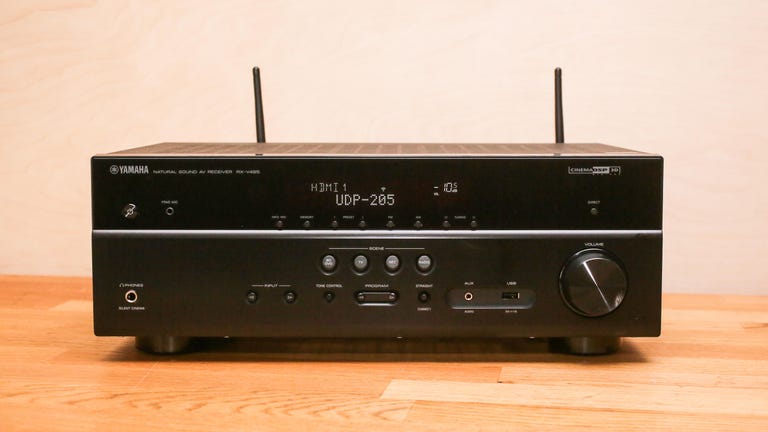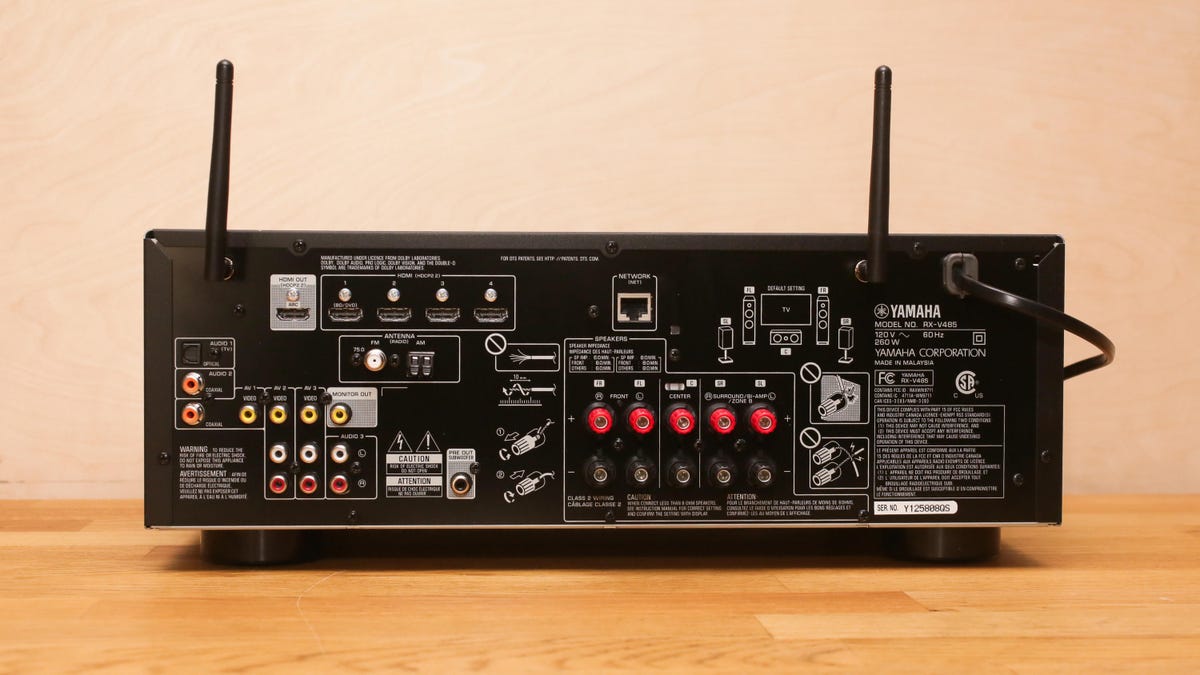 Why You Can Trust CNET
Why You Can Trust CNET Yamaha RX-V485 review: Affordable hub for an entry-level home-theater system
The Yamaha RX-V485 offers high-quality sound at an affordable price, but some users may crave better connectivity options and Dolby Atmos capability.
If you're choosing an affordable receiver from one of the Big Four receiver brands — Yamaha, Denon, Onkyo, and Sony — then you are probably used to comparing features lists with little cross marks next to items like "Feature A" and "Power handling B". When viewed against similarly priced receivers in this way you might have cause to overlook the Yamaha RX-V485, and that would be a pity. As long as your needs are basic, it's a solid choice.
The Good
The Bad
The Bottom Line
The RX-V485 is an affordable 5.1-channel receiver that also offers multiroom streaming -- and the option of wireless rear speakers -- via Yamaha's MusicCast system. It's available for $399, £379 or AU$799.
Read more: Best AV receivers of 2020
If you've ever seen a Yamaha receiver, there are no surprises when it comes to the design of the 485. It's boxy, it's black, and there are knobs. And buttons! I do like the direct shortcuts to the most popular inputs on the front. No more spinning the input wheel of fortune, just press Blu-ray and get your Blu-ray player.
HDMI connectivity on the Yamaha is a little scarce however, with only four inputs and a single output. This means if you are looking to add a new gaming console or streamer in the future you may have to purchase an additional HDMI switch. This receiver is a 5.1 system so no fancy "atmospheric" Atmos or DTS:X decoding here, just Dolby TrueHD and DTS:HD. Trading up to the 585 or 685 nets more inputs, amplifier power and the addition of Atmos.
Although the receiver lacks Apple's AirPlay 2 or Google's Chromecast multiroom systems, Yamaha's MusicCast offers multiroom streaming from a single powerful app. Whether you have a collection of music on a connected hard drive or stream from your phone's Spotify or Tidal app, this receiver will do that and do it well. New for 2018 is the ability to add wireless rears or a wireless sub (sold separately).
Adding wireless rears is a cinch with the MusicCast app
Features of an AV receiver are one of the most important considerations -- you need to know if it will have enough connections for all of your gear, and if it has enough power to drive your speakers (most do). Sound quality can be a little like comparing one sunny day to the next, there isn't always much to differentiate them.
One quick setup note: I found that you need to take calibrate the Yamaha manually, as the receiver's automatic calibration will add (unnecessary) processing to the audio your content if you don't defeat it with Direct Mode.
The Yamaha sounds great overall, but my listening tests did reveal subtle differences between it and the more-expensive Denon AVR-740H. The Denon AVR-S740H was a little better at keeping things together at volume with the Clash's Rock the Casbah, as the Yamaha got a little steely when towing the Q Acoustics 3050i at high levels. At normal volumes the Denon was also able to dredge up a little more detail such as the mobile phone-like sound at the mid-way point of the song.
With Alt-J's 3WW the Denon sounded a bit bigger with a greater sense of drama than the Yamaha -- the vocals and plucked guitars sounded a little more immediate, and the bass bed that underpins the track was thicker and richer.
Turning to home theater, the Denon's sounded a bit more theatrical when presenting The Rock's popcorn trifle Rampage. While the dialog -- such as it was -- was better communicated with the Yamaha, the Denon enhanced my sense of vertigo during Chapter 9. When the Rock straps in to a helicopter as it surf-crashes along the top of a collapsing Willis Tower, the Denon really elevated the fear the characters felt as they navigated among the pipes and concrete slabs of the disintegrating building. The Yamaha was still plenty muscular, but the Denon's extra power pushed it over the edge, so to speak.
Adding a pair of MusicCast 20s ($229 each) as wireless rears was an easy process via the MusicCast app. If you don't want to run wires across the room it's a great option, especially as the sound was so well integrated with the rest of the system. It does more than double your costs, though.
In the end, the Yamaha's lack of HDMI inputs and amplified channels seems a stingy compared to the Denon AVR-S740H -- especially when the Denon sounds a little better, too. It's worth noting here that the AVR-S740H isn't available outside the US, while Yamaha's receivers are.
On its own merits, the Yamaha is able to present music and movies with panache and the ability to add wireless rears adds a point of difference. It may not be the most exciting receiver in the world, but if you can get it for a good deal (street price is about $350) then the Yamaha RX-V485 presents a rock-solid buy.



